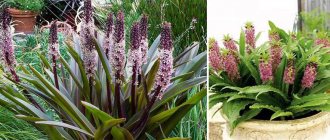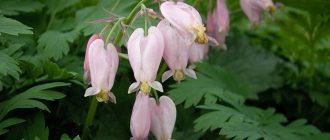The royal white lily is the most exquisite decoration of any flower garden. But this does not mean that caring for this majestic plant is difficult and burdensome.
It is undoubtedly necessary, but without being too labor-intensive, it allows you to achieve spectacular flowering of an excellent ornamental crop. Let's talk about planting and the main aspects of the necessary set of care measures.
Royal lily: description of the variety
Bred at the beginning of the last century, one of the most beautiful varieties bears the crowned name and is a representative of the most common type of trumpet lily. This is a tall, strong plant, reaching 1-1.2 m in height, with a strong, straight, bluish-green stem covered with narrow linear leaves. Their length is 7-15 cm, and their width is no more than 1.3-1.5 cm. Large tubular white flowers with strongly bent perianth petals reveal a copper-yellow pharynx and light green style and stigmas, covered with orange pollen. On the outside, the buds, reaching 13-15 cm in length, are covered with a violet-lilac coating. One stem can have up to 7-8 buds, and sometimes one flower can replace a whole bouquet. The seed capsule contains up to 200 seeds, which ripen by the end of September.
A feature of the crop is the ability to transmit all varietal characteristics using any method of propagation: both seeds and bulbs. Only the ripening time is different. After planting with seeds, the plant will delight you with flowers in the third year, and when propagated by bulbs - in the next season.
Useful tips
- When cutting Royal Lily flowers for a bouquet, it is important not to ruin the plant by shortening the stem too much. It is recommended to leave at least 7 leaves for the restoration process.
- In order for the bouquet to stand in the vase for more than 2 weeks, you need to cut off a shoot with at least five buds, one of them must be half-open.
- To prevent the table surface from getting dirty, the anthers must be carefully cut out with nail scissors.
- White lilies are a gift for young girls and for wedding celebrations.
Features of the view
Like many other bulbous crops, the royal lily is very unpretentious, but planting high-quality bulbs makes caring for the plant much easier. Therefore, when purchasing material, you should take a closer look and choose one that meets the following criteria:
- healthy appearance and elastic, fresh structure;
- absence of damage and rotten areas;
- tight fit of scales.
It is better to purchase lily bulbs in specialized stores. It is necessary to pay attention to the quality of their packaging. Typically, a conscientious grower who cares about maintaining his own reputation pays special attention to protecting the bulbs from external influences and packs them so that they are well preserved for spring planting.
The species qualities of the royal lily lie in the relatively calm attitude of the plant to short-term drying out of the soil and intolerance to excess moisture. Apparently, the origin of the flower plays a role - the homeland of wild-growing ancestors is the highland regions of China and Asia Minor, known for their harsh, dry climate. Therefore, when choosing a planting site, you should be guided by these features and remember that it will not be possible to grow a crop such as the royal lily in an area with a close approach of groundwater.
Botanical description
The royal lily is an elegant perennial flower. Its bulbs (planting material) are ovoid or spherical. The stem of the plant is erect, with many leaves. The flowers are collected in large inflorescences. One inflorescence includes from 10 to 15 pieces.
Some gardeners call the Chinese lantern lily. The fruit of the crop is presented in the form of an elongated seed capsule, which ripens in early October. Inside this box are several flat seeds.
Site selection and preparation
Lilies grow well in poor, light soils. Heavy clays and rich black soils significantly slow down their development, since they retain water and can cause rotting of roots and bulbs, which require enough air and a small amount of water. The optimal location is a sunlit place with loose, water- and breathable soil enriched with humus. Slightly acidic sandy loams and loams are most suitable for good plant growth and development.
If the soil in the garden is heavy, you will have to specially prepare the place: add river sand, peat or well-rotted plant residues. Experienced gardeners recommend avoiding adding fresh manure to the soil, as this can provoke damage to lilies by gray rot or fusarium.
Care after flowering
After flowering ends, cut off the seed pods. Don't trim the leaves or remove the stems just yet. If you need seeds, collect them. In early October, you can adjust the peduncle to 15 cm. It is not recommended to cut it off completely or leave a very small shoot.
Water the lily as usual, do not add too much water. As I already said, it is better to mulch the flower for the winter. Thanks to this, it will be better preserved until next year. By the way, you can cover the lily with spruce branches! In spring, do not rush to immediately remove the covering material, but remove the film. Remove the cover completely when warm weather arrives.
Royal lilies: planting and care
Before planting, purchased bulbs are soaked in a weak solution of manganese (for 2-3 hours) or a biostimulant, for example “Epin” or “Zircon” (according to the instructions for the drug).
This procedure will “wake up” the sleeping bulb, disinfect it and facilitate rooting. Lilies are planted in prepared holes according to patterns determined by purpose. In group planting, intervals between bulbs of 12-15 cm are allowed. The distance between groups should not be less than 40-45 cm. This is required to maintain the feeding area.
When planting in rows, the size of the bulbs plays a role: large ones are placed 20-25 cm apart from each other, and small ones - 15 cm. The intervals between rows should be at least 30-40 cm. The planting depth is also based on the size of the bulbs: above the top of the large ones should be be at least 15 cm of soil, above shallow soil - 10 cm. Children are buried by 6-8 cm. The royal lily tolerates planting well, quickly adapts and begins to grow. The preferred time for this is spring or early autumn, but if necessary, transplantation can be done at any time of the season.
Regale lily propagation methods
The Regal Lily reproduces by the usual division of bulbs, scales from them and even seeds. The seed and scaly methods will allow you to enjoy the flowering of Regale in the 3-7th year of life. The advantages of these methods are in the amount of growing material: if the goal is to have many flowers, you can plant flowers in groups without spending a lot of money on buying many bulbs.
Seeds
If the seeds are not needed, then at the moment of their formation on an adult plant, the capsules must be removed so that the vital forces are not wasted. Otherwise, the ripened flat seeds are removed in October-November and stored at +15 degrees.
Lily seeds
In February, seeds are sown in a heated greenhouse or containers on a windowsill, filled with a neutral, loose, moist substrate and covered with glass or film. Periodically, crops need to be checked, irrigated and ventilated. The room temperature is required +18…+20 °C.
Shoots are expected in three weeks, and then they need to find a place with a low temperature of +8...+12 °C, simulating early spring in the garden. After stable warmth is restored outside, and this will happen in late April - May, the seedlings can be transplanted into open ground and provided with the same conditions and care as for an adult plant.
Dividing the bulbs
Under excellent living conditions, the lily grows many high-quality “babies”, which need to be separated from the mother bulb at least once every 4 years. To do this, you need to carefully dig up this group in the fall, divide it, untangling the roots, and replant it in other places according to the recommendations for planting and subsequent care.
Lily propagation by dividing nests
Scales
This method, just as in the case of seeds, will provide a large number of new plants. In some cases, up to 2/3 of all scales can be removed from an adult bulb. They need to be soaked, dried, sprinkled on the wounds with activated carbon and placed in a container with sand or sphagnum moss, closed for 6 weeks at a temperature of +25 °C, and then for another 4 weeks at +16...+18 °C. When the bulbs form there, you need to put them in the refrigerator for storage. In August, plant in open ground.
It will also be interesting: Lily Big Brother - description, care, planting and cultivation?
Cultivation care
The royal lily, which is generally easy to care for, still dictates its own conditions. For example, to obtain high-quality flowers, it is necessary to protect the plant and place it under the protection of buildings, trees or shrubs, since their majestic inflorescences are damaged by winds and rain. But white lilies do not need to be replanted for a long time.
With good care, reproducing by dividing bulbs and building up impressive nests, they do not lose their decorativeness and productivity. This is the peculiarity of such a culture as the royal lily. The importance of caring measures for the development of the plant cannot be overestimated, since the care of the gardener allows the flowering of the crowned beauty to prolong.
Lily as a symbol
The image of a lily has had significance in various historical, world and national cultures. The Lilium regale symbol can be found in Egyptian hieroglyphs, Persian cryptography, the decor of antique dishes, on coins and jewelry. The lily flower is also often present in songs, legends, tales, rituals and beliefs.
The symbolism of the Bohemian and Polish gentry, as well as some states, includes the image of Lilium regale, which was a decoration of coats of arms, flags, standards, and military awards. In Christian traditions, white lily flowers are associated with the image of the Holy Virgin Mary, therefore Lilium regale was grown almost everywhere on the territory of monasteries. Today, this flower adorns garden plots and floral arrangements.
Digging and storing bulbs
If there are often frosty winters and little snow falls, lily bulbs are dug up for the winter. Be sure to transfer royal lilies, oriental hybrids and candidum lilies to storage. The bulbs are freed from the remaining soil, dried and placed in a cardboard box, the bottom of which is sprinkled with peat.
The laid layer on top is also sprinkled with peat. The material prepared for storage is placed in the refrigerator, cellar or on an insulated balcony. When choosing a place, take into account that it:
- well ventilated;
- was not too dry or wet;
- it was moderately warm.
The bulbs can be placed in a plastic bag with wet peat, tied and left indoors, choosing a dark place. After 3 months, the bulbs and the children are planted in peat pots
It is important that the tip is slightly visible above the ground. The pots are placed in the basement or cellar
3 weeks before planting in a permanent place, bring it into a bright, warm room and begin to water it.
Video “Secrets of growing lilies”:
The meaning of lily in human life
The importance of lilies in a person’s everyday life can hardly be overestimated. This is not only a wonderful element of interior decoration, but also useful properties with which you can overcome various ailments. The oil obtained from lilies has healing and softening properties. When the oil is mixed with calendula oil, the mixture is wonderful for very sensitive skin.
The oil can also be used for massage, in the bath, after the bath, for children, dry cuticles and elbows, as a moisturizer for the face and as an oil for the skin around the eyes.
The flower symbolizes purity and refined beauty. Depending on the color and type, a flower can convey different meanings.
| White | - modesty and integrity. |
| Orange | - passion. |
| Yellow | - fun. |
| Lily of the valley color | - good nature and purity of heart. |
Because of their stateliness and royalty, they acquired many symbolic meanings. It is also customary to give them as gifts for various celebrations. Among bouquets, the most common types are Casablanca and Oriental lily. In addition to bouquets, the bulbs of this plant have become a popular gift among women in our time.
Diseases and pests
Unfortunately, there are a large number of diseases and insects that can even destroy lilies. First of all, we are talking about fungal diseases: gray rot, blue mold, phytium, fusarium, rust and others. The problem is caused either by excess humidity or by poor agricultural practices. Damage occurs over the entire surface, from the bulbs to the petals. You can determine the presence of a fungal disease if you carefully examine the lily.
The appearance of plaque on the bulbs and mucus spots on the rest of the plant indicates a problem. In addition, due to excess moisture, the bulbs rot. Fungicides used to spray and kill damaged parts can help in this situation. As a preventive measure, it is enough to provide the lilies with proper care and avoid excess moisture.
In addition, a number of viral diseases cause problems for lilies. In this case we are talking about tobacco and cucumber mosaic, rosette disease and tulip variegation virus. In most cases, they are caused by pests, mainly aphids, or by the use of contaminated tools. The problem is identified by the condition of the leaves and stems - they turn yellow, become deformed, or become covered with pigment spots. Often the lily simply stops further development.
To cure a flower, you will first need to trim and destroy disease-prone parts of the bush, spray everything with the appropriate preparation, and then disinfect the equipment. Of the pests, lilies are attacked by almost 15 different types of insects, each of which attacks a specific part of the plant. For example, the spider mite drinks the juice, the line fly spoils the buds, the mole cricket and onion fly harm the bulbs, and the squeak beetle along with the larvae eats the leaves. Moreover, many of the pests carry viral diseases. For control, insecticides are always used, becoming counteraction against one or another insect. In some cases, additional digging of the soil and destruction of the larvae will be required.
Flower in landscape design
Lily is common in landscape design. There are different options for using garden crops on the site:
- in the form of a solo planting;
- in flower groups;
- in containers;
- under the crowns of plants that do not create shade.
In flower beds, the lily acts as a bright accent, combining well with evergreen shrubs, border plants, and tall flowers - delphiniums, gladioli, phlox. The flower is sometimes planted near ponds and in rockeries. The flowerbed on which lily varieties are planted looks interesting: the variety of shades, stem heights, and bud sizes is admirable.
Description and features of the flower
The royal lily (Latin Lilium regale) was first discovered in the Chinese province of Sichuan, where beautiful flowers can be found at altitudes from 800 to 2500 meters above sea level. In the wild, the plant prefers the banks of water bodies and rocky slopes.
They began to grow the plant only in 1910 - it was then that the botanist Wilson sent the bulbs to Massachusetts. At first, the species was cultivated only in America, but after the end of the First World War it came to Holland, and then spread throughout Europe.
The royal lily is a perennial herbaceous bulbous plant. The bulb is conical in shape, white and pink in color, formed by individual scales.
Its characteristic feature is a color change to purple-violet when exposed to air. The stem of the flower is quite long, but at the same time very strong, covered along its entire height with narrow lanceolate leaves arranged alternately.
Flowers with a strong aroma are the main advantage of lilies.
Dense inflorescences form from 5 to 15 flowers of characteristic colors. The outer side of the petals is always pink-violet, the inner side is white, with a yellow center. The diameter of the open funnel-shaped buds varies between 10-15 cm.
Typically, flowering occurs in mid-summer, in the second half of July, and lasts 2-3 weeks.











